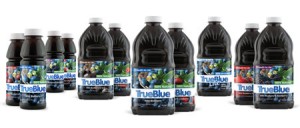Wedne sday afternoon – There were several foodstuffs in my lunch: soba noodles, onions and green and red peppers. Soba noodles, which is really Japanese vermicelli, is made in Korea (www.wangfood.com) of wheat flour, buckwheat, salt and water. The soba noodles are shipped from Korea by container to Canada. There are approximately 1000 containers on a ship. Each ship carries a mixture of 20 ft. (1900 kg.) and 40 ft. (3800 kg.) containers. The 40 ft. containers are standard and they can carry 26,000 kg. of product. Shipping costs for these containers are $2,000 – $3,000, brokerage fees $500, customs fees $1,500, and delivery fees $400 (www.seavilletransport.com). It takes approximately 17 days for the noodles to arrive in Canada. Fuel costs and other shipping costs were unavailable at the time of blogging. The onions were trucked from the Columbia Basin in WA to the Costco Distribution Centre in Langley, BC, a distance about 483 km. A standard reefer trailer is 45 ft. long and holds a payload of 21,772 kg. of product. The tractor unit that pulls the trailer has a diesel engine that gets approx. 0.4 km per litre of fuel (www.gotcanada.ca). A trip of 483 km at 0.4 km per litre would use 193 litres of fuel, which is roughly 1/3 of a tank of fuel (a full tank being approx. 605 litres). If we divide the 193 litres of fuel by the 21,772 kg of product it took approx. 0.009 litres of fuel to deliver a kg of goods to Vancouver from the Columbia Basin in WA. The individual weight of my portion of onions was far less than 1 kg, perhaps closer to 50 grams, so the cost to get that portion to Langley would be 0.009/20 or 0.00045 litres of fuel. A separate truck would distribute the onions to the individual T&T stores, but I was unable to ascertain the type of truck, its fuel consumption and its route.
sday afternoon – There were several foodstuffs in my lunch: soba noodles, onions and green and red peppers. Soba noodles, which is really Japanese vermicelli, is made in Korea (www.wangfood.com) of wheat flour, buckwheat, salt and water. The soba noodles are shipped from Korea by container to Canada. There are approximately 1000 containers on a ship. Each ship carries a mixture of 20 ft. (1900 kg.) and 40 ft. (3800 kg.) containers. The 40 ft. containers are standard and they can carry 26,000 kg. of product. Shipping costs for these containers are $2,000 – $3,000, brokerage fees $500, customs fees $1,500, and delivery fees $400 (www.seavilletransport.com). It takes approximately 17 days for the noodles to arrive in Canada. Fuel costs and other shipping costs were unavailable at the time of blogging. The onions were trucked from the Columbia Basin in WA to the Costco Distribution Centre in Langley, BC, a distance about 483 km. A standard reefer trailer is 45 ft. long and holds a payload of 21,772 kg. of product. The tractor unit that pulls the trailer has a diesel engine that gets approx. 0.4 km per litre of fuel (www.gotcanada.ca). A trip of 483 km at 0.4 km per litre would use 193 litres of fuel, which is roughly 1/3 of a tank of fuel (a full tank being approx. 605 litres). If we divide the 193 litres of fuel by the 21,772 kg of product it took approx. 0.009 litres of fuel to deliver a kg of goods to Vancouver from the Columbia Basin in WA. The individual weight of my portion of onions was far less than 1 kg, perhaps closer to 50 grams, so the cost to get that portion to Langley would be 0.009/20 or 0.00045 litres of fuel. A separate truck would distribute the onions to the individual T&T stores, but I was unable to ascertain the type of truck, its fuel consumption and its route.
The green and red peppers came from Prime Time, a produce conglomerate located in the Coachella Valley, CA. The peppers came to Vancouver by truck over a distance of about 1800 km. Assuming that the transport was a standard diesel, and plugging in the extra km, the shipping costs would be approx. 720 litres of fuel. Assuming that my portion of green and red peppers on Wednesday was approx. 100 grams, the cost of getting the peppers to Vancouver was 772/21,720= 0.033 litres of fuel to deliver a kg of goods to Vancouver from the Coachella Valley, CA. My portion that afternoon was approx. 100 grams of peppers, thus costing a miniscule amount of fuel.
Tea time (afternoon) – I drank TrueBlue blueberry juice, which is made in Alberta, but the blueberries are picked on the east coast of Canada from wild patches and trucked to Alberta, where they are juiced and containerized, then shipped to all parts of Canada. The distance the blueberries came is approx. 5000 km (from New Brunswick to Alberta), and the finished product was shipped another 1000 km, where it was distributed by local trucks throughout the Lower Mainland. The costs are similar to the costs listed above except that diesel fuel is cheaper in the US. ($1.21 per litre in Canada; $0.90 per litre in the US). The prunes I ate were grown on the Taylor Brothers Farm outside of Fresno, CA (approx. 1355 km from Vancouver). The same equation applies to the cost of fuel with a slight variation in distanced traveled. 